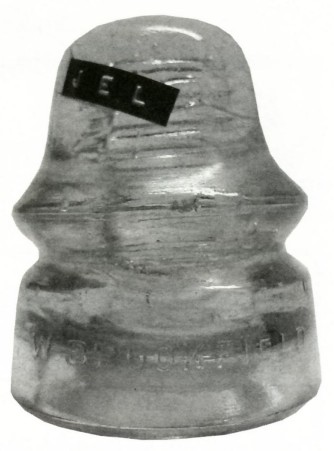Cold Pour
Reprinted from "Crown Jewels of the Wire", May 2006, page 18
Dario Dimare provided the explanation to Vernon Fellows' question about the
extra lettering on the dome of his Brookfield signal (April 2006 issue, page
43.)
Vernon ask if the embossed (raised) letters "J E L" were placed on
the dome by a factory worker carving his initials into the mold. We speculated
that the still-warm insulator might have bumped up against something that
resulted in a transfer of the lettering from the name "Brookfield",
and that the letters were really "I E L".

Dario says the letters are from the Brookfield name, but they came about
during the pouring of the glass, and not after it was poured. He explained that
a "cold pour" occurs when either the glass is too cool, or the mold
itself is cold. In either case, when (cold) glass is poured into a (cold) mold,
it is (or becomes) rather stiff like clay, rather than molten. As a fold of the
glass makes contact with the embossing, the letters are formed. But as more
glass enters the mold, the first portion may fold over, in this case, into the
dome area. Because the glass was too cool, the embossing is partially retained.
Dario says a clue that the extra letters were created in this manner is the
wrinkle of glass across the dome that indicates the glass folded over as the
insulator was being made.
According to Dario, a lot of so-called "ghost embossing" are
created in this manner. When inspecting one in your collection, watch for a
wrinkle in the glass in the vicinity of the extra embossing.
Dario also noted that if the "ghost embossing" occurred from a warm
insulator bumping into another object, the resulting letters would be incused
(sunken) instead of embossed (raised). Thanks, Dario, for explaining why extra
letters can sometimes appear in the strangest places on insulators.
| 